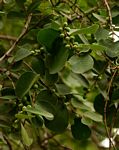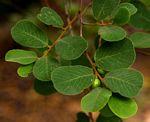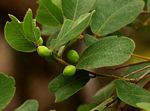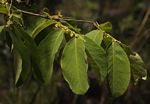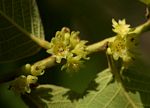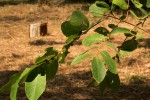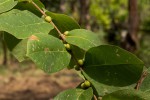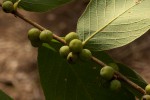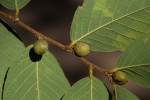| Home | > | List of families | > | Phyllanthaceae | > | Bridelia | > | mollis |
Bridelia mollis
Selected images: Click on each image to see a larger version and details of the record View all images (13)
Detailed records: Display species records QDS maps by: Google Maps Point records by Google Maps
Species details: Click on each item to see an explanation of that item (Note: opens a new window)
| Synonyms: |
Bridelia scandens sensu Eyles |
| Common names: | Velvet sweetberry (English) Velvet-leaved bridelia (English) |
| Frequency: | |
| Status: | Native |
| Description: |
Shrub or small tree. Bark dark brown to grey, rough with longitudinal striations; young shoots densely velvety. Leaves alternate, ovate to obovate, 3 - 12 cm long, light green and densely velvety on both surfaces; lateral veins conspicuously parallel; apex rounded, often notched; margin entire but sometimes appearing scalloped between the veins. Flowers in tight axillary clusters, small greenish-yellow, unisexual on the same tree. Fruit a subspherical fleshy berry, c. 10 × 8 mm, black when ripe, edible. |
| Type location: |
Mozambique |
| Notes: | |
| Derivation of specific name: | mollis: soft, referring to the velvety hairy leaves. |
| Habitat: | In sandy soils among rocks or on granite kopjes. |
| Altitude range: (metres) | |
| Flowering time: | Nov - Feb |
| Worldwide distribution: | Botswana, Malawi, Mozambique, Namibia, Zambia, Zimbabwe, and North-West, Limpopo, Mpumalanga, South Africa. |
| National distribution: | SE |
| Growth form(s): | |
| Endemic status: | |
| Red data list status: | |
| Insects associated with this species: | |
| Spot characters: | Display spot characters for this species |
| Images last updated: | Sunday 21 June 2015 |
| Literature: |
Burrows, J.E., Burrows, S.M., Lötter, M.C. & Schmidt, E. (2018). Trees and Shrubs Mozambique Publishing Print Matters (Pty), Cape Town. Page 410. (Includes a picture). Chapano, C. & Mamuto, M. (2003). Plants of the Chimanimani District National Herbarium and Botanic Garden, Zimbabwe Page 10. Chapano, C. & Mugarisanwa, N.H. (2003). Plants of the Matobo District National Herbarium and Botanic Garden, Zimbabwe Page 7. Drummond, R.B. (1975). A list of trees, shrubs and woody climbers indigenous or naturalised in Rhodesia. Kirkia 10(1) Page 251. Mapaura, A. & Timberlake, J. (eds) (2004). A checklist of Zimbabwean vascular plants Southern African Botanical Diversity Network Report No. 33 Sabonet, Pretoria and Harare Page 40. Radcliffe-Smith, A. (1996). Euphorbiaceae Flora Zambesiaca 9(4) Pages 13 - 14. Setshogo, M.P. (2005). Preliminary checklist of the plants of Botswana. Sabonet Report no. 37. Sabonet, Pretoria and Gaborone Page 55. Shone, D.K. & Drummond, R.B. (1965). Poisonous Plants of Rhodesia Ministry of Agriculture, Rhodesia Page 59. |
Other sources of information about Bridelia mollis:
Our websites:
Flora of Malawi: Bridelia mollisFlora of Mozambique: Bridelia mollis
Flora of Zambia: Bridelia mollis
Flora of Zimbabwe: Bridelia mollis
External websites:
African Plants: A Photo Guide (Senckenberg): Bridelia mollisAfrican Plant Database: Bridelia mollis
BHL (Biodiversity Heritage Library): Bridelia mollis
EOL (Encyclopedia of Life): Bridelia mollis
GBIF (Global Biodiversity Information Facility): Bridelia mollis
Google: Web - Images - Scholar
iNaturalist: Bridelia mollis
IPNI (International Plant Names Index): Bridelia mollis
JSTOR Plant Science: Bridelia mollis
Mansfeld World Database of Agricultural and Horticultural Crops: Bridelia mollis
Plants of the World Online: Bridelia mollis
Tropicos: Bridelia mollis
Wikipedia: Bridelia mollis
| Home | > | List of families | > | Phyllanthaceae | > | Bridelia | > | mollis |
